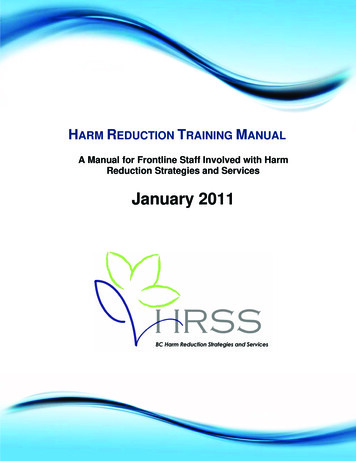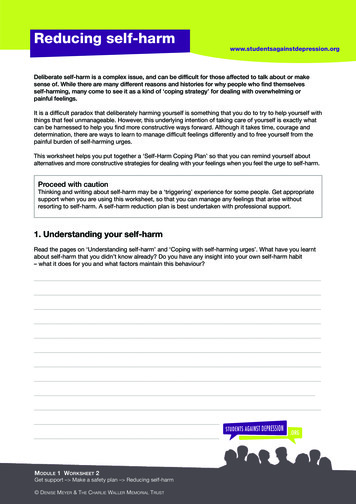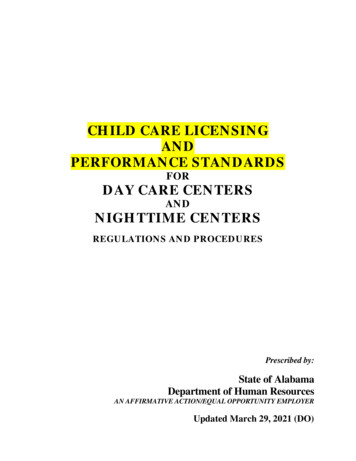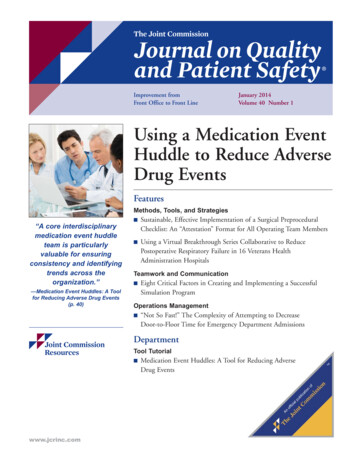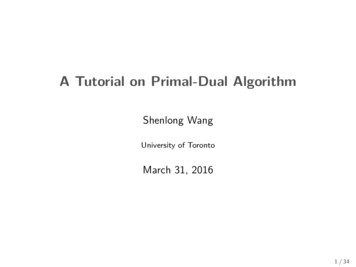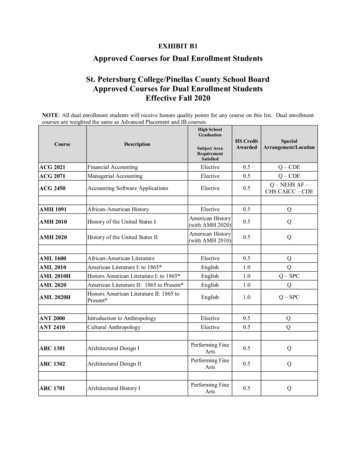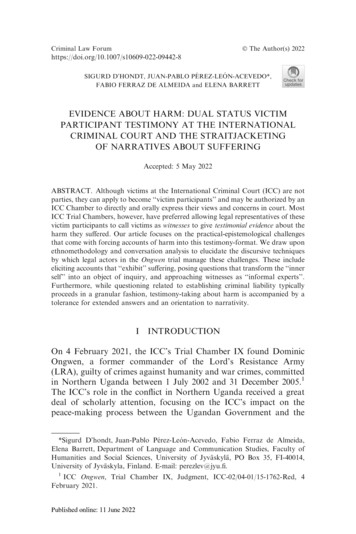
Transcription
The Author(s) 2022Criminal Law URD D’HONDT, JUAN-PABLO PÉREZ-LEÓN-ACEVEDO*,FABIO FERRAZ DE ALMEIDA and ELENA BARRETTEVIDENCE ABOUT HARM: DUAL STATUS VICTIMPARTICIPANT TESTIMONY AT THE INTERNATIONALCRIMINAL COURT AND THE STRAITJACKETINGOF NARRATIVES ABOUT SUFFERINGAccepted: 5 May 2022ABSTRACT. Although victims at the International Criminal Court (ICC) are notparties, they can apply to become ‘‘victim participants’’ and may be authorized by anICC Chamber to directly and orally express their views and concerns in court. MostICC Trial Chambers, however, have preferred allowing legal representatives of thesevictim participants to call victims as witnesses to give testimonial evidence about theharm they suffered. Our article focuses on the practical-epistemological challengesthat come with forcing accounts of harm into this testimony-format. We draw uponethnomethodology and conversation analysis to elucidate the discursive techniquesby which legal actors in the Ongwen trial manage these challenges. These includeeliciting accounts that ‘‘exhibit’’ suffering, posing questions that transform the ‘‘innerself’’ into an object of inquiry, and approaching witnesses as ‘‘informal experts’’.Furthermore, while questioning related to establishing criminal liability typicallyproceeds in a granular fashion, testimony-taking about harm is accompanied by atolerance for extended answers and an orientation to narrativity.I INTRODUCTIONOn 4 February 2021, the ICC’s Trial Chamber IX found DominicOngwen, a former commander of the Lord’s Resistance Army(LRA), guilty of crimes against humanity and war crimes, committedin Northern Uganda between 1 July 2002 and 31 December 2005.1The ICC’s role in the conflict in Northern Uganda received a greatdeal of scholarly attention, focusing on the ICC’s impact on thepeace-making process between the Ugandan Government and the*Sigurd D’hondt, Juan-Pablo Pérez-León-Acevedo, Fabio Ferraz de Almeida,Elena Barrett, Department of Language and Communication Studies, Faculty ofHumanities and Social Sciences, University of Jyväskylä, PO Box 35, FI-40014,University of Jyväskyla, Finland. E-mail: perezlev@jyu.fi.1ICC Ongwen, Trial Chamber IX, Judgment, ICC-02/04-01/15-1762-Red, 4February 2021.
SIGURD D’HONDT ET AL.LRA and the complex, at times conflict-fraught interactions with localreconciliation initiatives.2 Moreover, there is growing awareness amongresearchers and practitioners that the ICC represents one among a rangeof transitional justice mechanisms, including truth commissions, reparations programmes, and institutional reforms.3 In this context, victimparticipation is generally recognized as a necessary requirement fortransitional justice mechanisms such as the ICC.4Victims of international crimes under the ICC’s jurisdiction canintervene in ICC proceedings in two procedural roles: as witnesses(and give testimony),5 or as victim participants (and present theirviews and concerns).6 If the accused is found guilty, they can alsoclaim and receive reparations from the convicted.7 For clarity, thispaper reserves the expression victim participation for referring to thevictim participant role sensu stricto, and uses victim intervention as acover term for victims’ involvement in the proceedings in general,either in the witness or victim participant role. Importantly, victimsmay be involved in the process in both roles at once, as victim participants can also be allowed to give testimony (in the witness role). Inthat capacity, they are referred to as dual status victims (DSV).This double procedural role illustrates the influence of restorativejustice at the ICC, which is clearly reflected in the Court’s mandate. It2E.g., Adam Branch, ‘‘Dominic Ongwen on Trial: The ICC’s African Dilemmas’’,11 International Journal of Transitional Justice (2017) 30–49; Anna Macdonald, ‘‘ÔInthe Interests of justice?’ The International Criminal Court, peace talks and the failedquest for war crimes accountability in northern Uganda’’, 11 Journal of EasternAfrican Studies (2017) 628–648; Joseph Wasonga, The International Criminal Courtand the Lord’s Resistance Army (London, Routledge, 2021).3E.g., UN Security Council, The Rule of Law and Transitional Justice in Conflictand Post-Conflict Societies: Report of the Secretary General, S/2004/616; GraemeSimpson, ‘‘One Among Many: The ICC as a Tool of Justice during Transition’’ inNicholas Waddell and Phil Clark (eds), Courting Conflict? Justice, Peace and the ICCin Africa (London, Royal African Society 2008); Obiora Okafor and UchechukwuNgwaba, ‘‘The International Criminal Court as a ÔTransitional Justice’ Mechanismin Africa: Some Critical Reflections’’ 9 International. Journal of Transitional Justice(2015) 90–108; African Commission on Human and Peoples’ Rights, ‘‘Study onTransitional Justice and Human and Peoples’ Rights in Africa’’ (2019).4E.g., Juan Méndez, ‘‘Victims as Protagonists in Transitional Justice’’, 10 International Journal of Transitional Justice (2016), 2–3; Raquel Aldana, ‘‘A VictimCentered Reflection on Truth and Reconciliation Commissions and Prosecutions asa Response to Mass Atrocities’’, 5 Journal of Human Rights (2006), 107–126.5See Articles 68(1)-(2) and 69(1)-(2) ICC Statute.6Article 68(3) ICC Statute.7Article 75 ICC Statute.
EVIDENCE ABOUT HARM: DUAL STATUS VICTIM PARTICIPANTis because the restorative justice paradigm regards victims of crimesas subjects rather than objects,8 that victims hold this ‘‘enhanced’’procedural role (beyond that of witness) and the rights associatedwith it in an international criminal justice institution such as theICC.9 This is, in turn, consistent with a growing awareness thattransitional justice processes need to acknowledge victims’ needs,10counteracting critiques of earlier international criminal tribunals thatdid not allow victims to tell their own stories.11 Academics haveacknowledged that transitional justice can be victim-centred.12 Insocieties transitioning from mass atrocities, victims’ active roles in(international) criminal justice proceedings may illustrate restorativeand reparatory practices, guided by specific goals concerning victimsand their communities.13 However, empirical studies on the perceptions and opinions of victims and their communities in Uganda andin other African countries related to ICC’s investigations and casesreveal a mixed picture about the way victims’ procedural roles areimplemented at the ICC.14 Moreover, partial mishandling of theseprocedural roles has also led to tensions with the accused’s rights.15In this article, we examine how victims’ different procedural rolesat the ICC have been implemented in the recently concluded Ongwen8Mariana Pena and Gaelle Carayon, ‘‘Is the ICC Making the Most of VictimParticipation?’’, 7 International Journal of Transitional Justice (2013) 523.9Brianne McGonigle-Leyh, Procedural Justice? Victim Participation in International Criminal Proceedings (Cambridge, Intersentia, 2011) 40–41, 55.10Pena and Carayon, supra, (n. 8), p. 518; Simon Robins, ‘‘Challenging theTherapeutic Ethic: A Victim-Centred Evaluation of Transitional Justice Process inTimor Leste’’, 2012 International Journal of Transitional Justice (2012) 83–105.11Pena and Carayon, supra, (n. 8), pp. 520–522.12Aldana, supra, (n. 4); Juan Mendez, ‘‘National Reconciliation, TransnationalJustice, and the International Criminal Court’’, 15 Ethics & International Affairs 25(2001); Marcos Zunino, Justice Framed: A Genealogy of Transitional Justice(Cambridge, Cambridge University Press, 2019) 36–37.13Ruti Teitel, Transitional Justice (Oxford, Oxford University Press, 2000) 127.See also UNODC, Handbook on Restorative Justice Programmes (March 2020).14E.g., Stephen Cody, ‘‘Procedural Justice, Legitimacy, and Victim Participationin Uganda’’, in Nobuo Hayashi and Cecilia Bailliet (eds), The Legitimacy of International Criminal Tribunals (Cambridge, CUP, 2017) 376–398; Stephen Cody et al.‘‘The Victims’ Court? A Study of 622 Victim Participants at the InternationalCriminal Court’’ (Human Rights Center/UC Berkeley Law School, 2015); Pena andCarayon, supra, (n. 8).15See Sergey Vasiliev, ‘‘Victim Participation Revisited’’, in Carsten Stahn (ed),The Law and Practice of the International Criminal Court (Oxford, Oxford UniversityPress, 2015) 1133–1201; McGonigle-Leyh, supra, (n. 9), pp. 346–362.
SIGURD D’HONDT ET AL.trial. Like in other ICC trials, Trial Chamber IX interpreted andimplemented victim participation rather restrictively, and it categorically refused to authorize (even a limited number of) victim participants to present their views and concerns directly and orally beforethe Court. In May 2018, the Legal Representatives for Victims (LRV)in Ongwen filed a request for: (i) two community leaders (arguablyrepresenting the diversity of victim participants in Ongwen) to presenttheir views and concerns orally; and (ii) five DSVs to give testimonyon harm.16 In its decision, Trial Chamber IX allowed three DSVs togive testimony on harm, but rejected the requested oral presentationof views and concerns.17 With this decision, the Chamber followedthe ICC’s established preference for witness testimony over victimparticipants’ views and concerns, as the large majority of TrialChambers have systematically disallowed victim participants to present their views and concerns directly and orally before the judges,except Trial Chamber III in Bemba.18 Victim participation must always be balanced against competing interests and rights, and on thisground certain authors have argued that, mainly because of the veryhigh numbers of victim participants at the ICC, restricting victimparticipation enables the Court to better ensure procedural efficiencyand offers stronger guarantees for the protection of the accusedperson’s rights.19 Nevertheless, completely disallowing the direct andoral presentation of views and concerns also has questionable consequences, which many authors appear to have overlooked so far. Inthis paper, we document some of these consequences.As a result of Trial Chamber IX’s decision, DSV intervention inOngwen was restricted to: (i) presentation of written views and concerns (in the victim participant role), of which the LRV presented anoral summary in court; and (ii) oral testimony (in the witness role),16See ICC, Ongwen, Trial Chamber IX, Decision on the Legal Representatives forVictims Requests to Present Evidence and Views and Concerns and related requests,ICC-02/04-01/15-1199-Red, 6 March 2018, paras. 9, 70 (hereinafter Ongwen VictimsDecision).17Ibid., p. 26.18Bemba, Trial Chamber III, Decision on the supplemented applications by thelegal representatives of victims to present evidence and the views and concerns ofvictims, ICC-01/05-01/08-2138, 22 February 2012, paras. 15–17.19See generally Salvatore Zappalà, ‘‘The Rights of Victims v. the Rights of theAccused’’, 8 Journal of International Criminal Justice (2010) 137–164; Vasiliev, supra,(n. 15), pp. 1133–1201; McGonigle-Leyh, supra, (n. 9), pp. 225–366; Luke Moffett,‘‘Meaningful and Effective? Considering Victims’ Interests Through Participation atthe International Criminal Court’’, 26 Criminal Law Forum (2015) 255–289.
EVIDENCE ABOUT HARM: DUAL STATUS VICTIM PARTICIPANTeither called by the Prosecutor to give evidence on the charged crimesand criminal liability or by the LRV to give evidence on harm inflicted on victims. In this article, we focus on the three DSVs thatTrial Chamber IX authorized to testify on harm inflicted on thevictims, as it is here that the tension between the witness and victimroles is most outspoken. In its decision, Trial Chamber IX gave theLRVs permission to examine each DSV in relation to a specific aspectof harm: the stigma experienced by returned abductees: a former child soldier (henceforth ‘‘first witness’’) who testified on 1 May 2018; the impact of the abductions on the victims’ education: a Lukodischoolteacher (henceforth ‘‘second witness’’) who testified on 2May 2018); and the interrelated and cumulative nature of various kinds of harm: acommunity leader (henceforth ‘‘third witness’’) who testified on 3May 2018).20The LRVs furthermore called five expert witnesses, who also testified in May 2018. Before that, the Prosecutor had already calledseveral DSVs to testify on matters related to the charged crimes andOngwen’s liability (in 2017 and January 2018). However, since theywere not called to give evidence on harm inflicted on victims, they areless centrally relevant to our study.The remainder of the paper charts the consequences of curtailingDSV interventions in Ongwen in this way. To this end, we examine indetail those interventions that DSVs were allowed to make, in thewitness role, when called by the LRV to give testimony about harm.To chart what happens when these DSV narratives of suffering aresubjected to the question-answer format of testimony-taking, weprovide an in-depth analysis of the court transcripts available on theICC’s website. These transcripts provide a detailed record of the trialactors’ interactional conduct as the trial progresses, thus offering awindow into the ‘‘black box’’ of what goes on inside the courtroomthat would be unavailable if one only examines judicial decisions. Forthis, we draw on Ethnomethodology and Conversation Analysis(EMCA),21 an approach to spoken interaction that seeks to elucidatethe discursive methods and language resources that speakers rely on2021Ongwen Victims Decision, para. 9 and p. 26.Harvey Sacks, Lectures on Conversation (Oxford, Blackwell, 1992); Jack Sidnelland Tanya Stivers, Handbook of Conversation Analysis (Hoboken, Wiley-Blackwell,2013).
SIGURD D’HONDT ET AL.for maintaining intersubjectivity in interaction. In this case, we resortto EMCA for uncovering the methods that LRVs, judges and witnesses use for co-producing accounts of suffering that meet therequirements of the testimony format. EMCA scholars have a longtradition of looking at the law as a practical, intersubjective accomplishment,22 but our research is one of the first to use this approach instudying international criminal tribunals.The article starts with a legal-normative analysis into the natureand content of the categories ‘‘testimony’’ and ‘‘views and concerns’’.In ‘‘Views and Concerns Versus Testimony: A Normative Demarcation’’ we show that, despite the apparent clarity with which judgesand practitioners apply these notions, remarkably few attempts havebeen undertaken to delineate these categories in positive terms. In theremainder of the paper, we redirect attention from judicial decisions(output) to the interactions over the course of trial hearings (process)and examine the consequences of this indeterminacy in actual ICCtrial practice. In the section ‘‘Delineating the Scope of DSV Testimony as a Practical Problem’’, we show how for the trial actors inOngwen, determining the precise scope of testimony about harmconstitutes a ‘‘local’’ problem that requires case-by-case consideration and for which they have to negotiate an ad hoc solution. In thenext two sections, we turn to the actual presentation of testimonyabout harm in court and examine how this was done in the Ongwen’strial. In ‘‘Methodologies for Establishing Harm’’, we start withreviewing the discursive techniques used by the LRV, and at timesalso by the presiding judge, for eliciting accounts of suffering that areconsistent with the testimony format. In passing, we point out howthey differ from questioning strategies used for eliciting evidenceabout facts related to criminal liability. In ‘‘Narrativity and Granularity’’, we show that testimony-taking about harm goes hand-inhand with a tolerance for extended answers and a preference for‘‘narrativity’’. Again, this is much less the case in testimony meant toelicit evidence related to criminal liability. In the ensuing‘‘Discussion’’, we argue that the discursive techniques used for eliciting testimony about harm, and the tension between narrativity andgranularity that such testimony exhibits, are very much indicative of22Baudouin Dupret, Michael Lynch, and Tim Berard, (eds), Law at Work (NewYork, Oxford University Press, 2015); Paul Drew and Fabio Ferraz de Almeida,‘‘Order in Court: Talk in Interaction in the Judicial Process,’’ in The RoutledgeHandbook of Forensic Linguistics 2nd ed., eds. Malcolm Coulthard, Alison May, andRui Sousa-Silva, (Oxon: Routledge, 2021), 177–191.
EVIDENCE ABOUT HARM: DUAL STATUS VICTIM PARTICIPANTthe core problematic surrounding the ICC’s jurisprudential policy ofrestricting victims’ oral and direct intervention to testimony. Theyillustrate the effort it takes to straitjacket accounts of suffering, whichtranscend the boundaries between fact/feeling and past/present/future, into a format designed to elicit evidence about clearly circumscribed events.II VIEWS AND CONCERNS VERSUS TESTIMONY: A NORMATIVE DEMARCATIONAs previously indicated, DSVs can at the ICC either be called toprovide testimonial evidence (the witness role), or they can be judicially authorised to deliver oral and/or written views and concerns(the victim participant role). Article 68(3) of the ICC Statute establishes the victim participant role and states that victims can be allowed to actively participate in the trial: ‘‘Where the personalinterests of the victims are affected, the Court shall permit their viewsand concerns to be presented’’.23 However, neither the ICC Statutenor the ICC Rules of Procedure and Evidence establish that victimparticipants can also be witnesses in the same case or the same procedural stage. Although some scholars and practitioners (includingformer ICC Judge Jorda) initially opposed dual status victim participation on the grounds that it could compromise the accusedperson’s rights,24 the ICC has in practice allowed this duality.25 In23For commentaries on Article 68(3) of the ICC Statute, see generally: WilliamSchabas, The International Criminal Court: A Commentary on the Rome Statute (2ndedn, Oxford, Oxford University Press, 2016) 1062-1071; David Donat-Cattin,‘‘Article 68’’ in Kai Ambos (ed.), Rome Statute of the International Criminal Court:Article-by-article Commentary (4rd edn, Munich/Oxford/Baden-Baden, Beck/Hart/Nomos, 2022) 2001-2036; and Enrique Carnero-Rojo, ‘‘Article 68’’ in Mark Klamberg (ed), Commentary on the Law of the International Criminal Court (Brussels,Torkel Opsahl Academic EPublisher, 2017) 520–528.24Claude Jorda and Jérôme de Hemptinne, ‘‘The Status and the Role of Victim’’,in Antonio Cassese et al. (eds), The Rome Statute of the International Criminal Court:A Commentary, Vol. II (Oxford, Oxford University Press, 2002) 1387, 1409.25E.g., ICC, Lubanga, Judgment on the appeals of The Prosecutor and The Defence against Trial Chamber I’s Decision on Victims’ Participation of 18 January2008, Appeals Chamber, ICC-01/04-01/06-1432, 11 July 2008 (hereinafter LubangaJudgment on Appeals against Victims’ Participation Decision); ICC, Katanga andNgudjolo Chui, Directions for the conduct of the proceedings and testimony inaccordance with rule 140, Trial Chamber II, ICC-01/04-01/07-1665, 20 November2009 (hereinafter Katanga and Ngudjolo Chui Directions for Proceedings and Testimony); ICC, Katanga and Ngudjolo Chui, Judgment on the Appeal of Mr Katanga
SIGURD D’HONDT ET AL.this way, the Court appears to have acted on the basis of the legalmaxim whereby everything that is not explicitly forbidden is allowed,as the ICC instruments do not explicitly prohibit DSVs.Before being allowed to testify as a witness, victim participantsalso need judicial authorization. Here, ICC jurisprudence has clarified that ‘‘the Chamber will only grant applications on behalf ofvictims whose testimony can make a genuine contribution to theascertainment of the truth’’,26 and provided that there are sufficientguarantees for the accused person’s rights.27 ICC Chambers havethus rejected accepting victims appearing at the ICC automatically aswitnesses, 28 and they have also taken into account whether holdingdual status would negatively affect the accused person’s rights.29 Inany event, victims who ‘‘fail to reach the threshold to be authorised togive evidence may still be permitted to express their views and concerns in person’’.30At the same time, however, the ICC legal instruments lack (clear)definitions of ‘‘witness’’, ‘‘testimony’’, and ‘‘views and concerns’’ andrefrain from making an unambiguous distinction between these notions based on their specific contents. The travaux pre paratoires of theICC instruments provide no explicit or detailed definition of ‘‘viewsFootnote 25 continuedAgainst the Decision of Trial Chamber II of 22 January 2010 Entitled ‘‘Decision onthe Modalities of Victim Participation at Trial’’, Appeals Chamber, ICC-01/04-01/07-2288, 16 July 2010 (hereinafter Katanga and Ngudjolo Chui Judgment on theAppeal against Decision on Victim Participation Modalities at Trial).26Katanga and Ngudjolo Chui Directions for Proceedings and Testimony, para. 20.See also, e.g., Katanga and Ngudjolo Chui Judgment on the Appeal against Decisionon Victim Participation Modalities at Trial, para. 3; Lubanga Judgment on Appealsagainst Victims’ Participation Decision, paras. 94–95.27Katanga and Ngudjolo Chui Directions for Proceedings and Testimony, paras.21-23; Katanga and Ngudjolo Chui Appeal against Decision on Victim ParticipationModalities at Trial, para. 3; Lubanga Judgment on Appeals against Victims’ Participation Decision, para. 96.28ICC, Lubanga, Decision on Victims’ Participation, Trial Chamber I, ICC-01/0401/06-1119, 18 January 2008, para. 132 (hereinafter Lubanga Victims ParticipationDecision).2930Ibid., paras. 132, 134.ICC, Bemba, Decision on the supplemented applications by the legal representatives of victims to present evidence and the views and concerns of victims, TrialChamber III, ICC-01/05-01/08-2138, 22 February 2012, para. 20 (hereinafter BembaVictims Decision).
EVIDENCE ABOUT HARM: DUAL STATUS VICTIM PARTICIPANTand concerns’’,31 and the first sentences of Article 68(3) essentiallyrecapitulate the 1985 UN Declaration of Basic Principles of Justicefor Victims of Crime and Abuse of Power.32ICC jurisprudence gives some indications of how the Courtunderstands these notions, but it does not provide precise definitionsand fails to clearly differentiate between ‘‘testimony’’ and ‘‘views andconcerns’’. Concerning ‘‘testimony’’, for example, Trial Chamber VIIin Bemba established that: ‘‘Not every conversation a person has orevery communication provided by the person qualifies as ‘‘testimony’’ – it is rather only those where persons are questioned in theircapacity as witnesses in the context of or in anticipation of legalproceedings’’.33 In turn, Trial Chamber II in Katanga and NgudjoloChui determined that:[a] key factor in determining whether an out-of-court statement qualifies astestimony in the sense of article 67(l)(e) and rule 68 is that the person makingthe statement understands, when making the statement, that he or she isproviding information which may be relied upon in the context of legal proceedings [ ] It is important [ ] that the statement is formalised in somemanner and that the person making the statement asserts that it is truthful andbased on personal knowledge. A unilaterally prepared affidavit may thus alsoqualify as testimony if the person making it clearly had the intention of makingfactual assertions for the purpose of future or ongoing legal proceedings.3431See Draft Statute of the International Criminal Court, Working paper submitted by France, UN Doc. A/AC.249/L.3, 6 August 1996, Articles 50(3), 126,130(2); Proposal for Article 43 Submitted by Egypt, UN Doc. A/AC.249/WP.11, 19August 1996, Article 43(2)(b); Proposal by New Zealand on Article 43, Non-Paper/WG.4/No.19, 13 August 1997, Article 43(3); Article 68, Protection of the Victimsand Witnesses and Their Participation in the Proceedings: Proposal Submitted byCanada, UN Doc. A/CONF.183/C.1/WGPM/L.58/Rev.1, 6 July 1998; and Article68(3) Report of the Working Group on Procedural Matters, UN Doc. A/CONF.183/C.1/WGPM/L. 2/Add.6, 11 July 1998, p. 4.32UN Declaration of Basic Principles of Justice for Victims of Crime and Abuseof Power, UN Doc. A/RES/40/34, 29 November 1985, 6(b) (‘‘Allowing the views andconcerns of victims to be presented and considered at appropriate stages of theproceedings where their personal interests are affected, without prejudice to theaccused and consistent with the relevant national criminal justice system’’). See alsoDonat-Cattin, supra, (n. 23), pp. 2007-2008, mn. 8.33ICC, Bemba et al., Corrigendum of public redacted version of Decision onProsecution Rule 68(2) and (3) Requests, Trial Chamber VII, ICC-01/05-01/13-1478Red-Corr, 12 November 2015, para. 32.34ICC, Katanga and Ngudjolo Chui, Decision on the Prosecutor’s BarTable Motions, Trial Chamber II, ICC-01/04-01/07-2635, 17 December 2010, para.49.
SIGURD D’HONDT ET AL.ICC jurisprudence has only to a limited extent fleshed out the meaningof views and concerns, mainly by reiterating the intrinsic connection tothe victim participants’ personal interests established in Article 68(3):‘‘general interests of the victims are very wide-ranging and include aninterest in [ ] being allowed to express their views and concerns’’35 or‘‘any views and concerns of victims in relation to issues which affecttheir interests’’.36 Apart from noting that they are the ‘‘equivalent ofpresenting submissions’’,37 ICC Chambers have not defined views andconcerns in positive terms.38 It has been established that they are notevidence, not delivered under oath, and cannot be subject to crossexamination.39 Other than that, however, jurisprudence has not clearlyexplained how DSV’s views and concerns differ from DSV’s testimony,particularly testimony on harm inflicted on victims.Among legal scholars, only very few have attempted to clearly defineviews and concerns. According to Donat-Cattin, they represent broadterms ‘‘inclusive enough to allow victims (or their representatives) tobring before the Court elements of evidence upon which they wish toexpress views or concerns’’.40 Bachvarova refers to views and concernsas victim participants’ entitlement ‘‘to voice their stance, convey theiremotions and put forward their preoccupations on the issue at stake’’.41McDermott comments that views and concerns involve ‘‘anything related to the proceedings, from relaying personal experiences to discontent related to the speed or efficiency of the trial’’.4235Lubanga Victims Participation Decision, para. 97.36ICC, Ruto and Sang, Decision on the ‘‘Request by the Victims’’ Representativefor authorisation to make a further written submission on the views and concerns ofthe victims’, Pre-Trial Chamber II, ICC-01/09-01/11-371, 9 December 2011, para. 13.37ICC, Lubanga, Decision on the Request by Victims a/ 0225/06, a/0229/06 and a/0270/07 to Express their Views and Concerns in Person and to Present EvidenceDuring the Trial, Trial Chamber I, ICC-01/04-01/06-2032-Anx, 26 June 2009, para.19 (hereinafter Lubanga Victims Request Decision).38But see separate opinion of Judge Pikkis using textual interpretation of Article68(3) to flesh out the meaning of ‘‘views and concerns’’, ICC, Lubanga, SeparateOpinion of Judge Georghios Pikis (Appeals Chamber), ICC-01/04-01/06-925, 13June 2007, para. 15.39See, e.g., Lubanga Victims Request Decision, para. 19; Bemba Victims Decision,para. 19.40Donat-Cattin, supra, (n. 23), p. 2020, mn. 23.41Tatiana Bachvarova, The Standing of Victims in the Procedural Design of theInternational Criminal Court (Leiden, Brill, 2017) 142.42Yvonne McDermott, ‘‘Some Are More Equal than Others: Victim Participationin the ICC’’, 5 Eyes on the ICC (2008–2009) 41.
EVIDENCE ABOUT HARM: DUAL STATUS VICTIM PARTICIPANTIn addition to the already quoted jurisprudence, we would alsolike to draw attention to an ICC booklet published in 2006, whichdefines a witness as ‘‘a person who gives evidence before the Court bytestimony. A witness is normally called by the Prosecutor, who istrying to prove the criminal case against an accused, or the defence’’.43 The ICC website furthermore identifies different kinds ofwitnesses: expert witnesses testify about matters within their expertise(e.g., forensic experts), overview witnesses help determine contextualfacts (e.g., NGO representatives), insider witnesses possess a directconnection with the accused, while fact witnesses ‘‘have knowledgeand testify about what happened. They can be crimes-based witnesseswhen they have suffered harm and testify as witnesses about whathappened to them. Some of these witnesses can also hold the status ofparticipating victims before the Court; they are called dual-statuswitnesses’’.44The quote indicates that victims testifying as witnesses are offundamental importance to the ICC. Before the trial, their testimonyenables the Prosecutor to gather information about crimes committed, so that an investigation can be started and a strong case can besubmitted.45 During the trial, they can be called by the Prosecutor,the defence and the Chamber to give testimony about the charges,and by victim participants or their LRV to give evidence on the harmthey suffered,46 as happened in Ongwen.47 Victims who appear aswitnesses only intervene when they are called to testify,48 and usuallythey are not represented by lawyers.49 They provide testimony (evidence) by answering questions posed to them,50 and hence theirintervention is subject to tight constraints:43ICC, ‘‘Victims Before the International Criminal Court’’ (2006) 28, 0VPRSBookletEnglish.pdf (last accessed 1 December2021).44ICC, ‘‘Witnesses’’, available online: https://www.icc-cpi.int/about/witnesses(last accessed 1 December 2021).45Jo-Anne Wemmers, ‘‘Victims’ Rights and the International Criminal Court:Perceptions within the Court Regarding the Victims’ Right to Par
societies transitioning from mass atrocities, victims' active roles in (international) criminal justice proceedings may illustrate restorative and reparatory practices, guided by specific goals concerning victims and their communities.13 However, empirical studies on the percep-tions and opinions of victims and their communities in Uganda and
